|
Eurobot Competitions
1998-2004
|
|
The rules of the Eurobot Contest differ every year but the general rules are always the same: two teams of robots limited in size and number are placed on the same truck and must complete a mission in 90 seconds. The team which complete the mission in a better way than the opposite one win. The criterion of selection of the winner team is based on a set of rules that specify the points earned for each sub-goal reached by the robots.
|
|
1998
|
 The 1998 was the first year that the University of Catania participated to a mobile robot international competition, for this reason the team had to set up a completely new project of an autonomous robot.
The rules of the Eurobot Competition were very similar to a football match with more than one ball: on a totally flat track with eight tennis balls all over it, the two opposite robots had to score as much goals as possible. A dual drive system was designed and realized and an embedded PC 386 was initially adopted to implement the robot intelligence, but due to a malfunction during the last week of trials, it was necessary to change in the last moment the central computer to a HandyBoard (6811-based microcontroller system) programmed in Interactive C.
The two DC motors were commanded using two PWM signals. Another motor was used to drive a cylindrical brush to collect and then to shot the tennis balls forward to score goals. The robot was equipped with light sensors to follow the white lines on the field. IR transmitter and receivers have been adopted to help the robot recognizing its position.
The 1998 was the first year that the University of Catania participated to a mobile robot international competition, for this reason the team had to set up a completely new project of an autonomous robot.
The rules of the Eurobot Competition were very similar to a football match with more than one ball: on a totally flat track with eight tennis balls all over it, the two opposite robots had to score as much goals as possible. A dual drive system was designed and realized and an embedded PC 386 was initially adopted to implement the robot intelligence, but due to a malfunction during the last week of trials, it was necessary to change in the last moment the central computer to a HandyBoard (6811-based microcontroller system) programmed in Interactive C.
The two DC motors were commanded using two PWM signals. Another motor was used to drive a cylindrical brush to collect and then to shot the tennis balls forward to score goals. The robot was equipped with light sensors to follow the white lines on the field. IR transmitter and receivers have been adopted to help the robot recognizing its position.
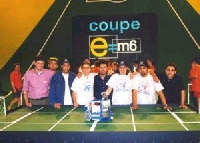
The Team: Sebastiano Chillari Manuela La Rosa Daniele Agazzani Giovanni Strano Giusy Tomarchio Salvatore Di Stefano |
|
1999
|
 In 1999 the track was divided in two by a ravine with two bridges. On each side, a castle made by wooden cylinders was placed in front of the robot start position. Each team had to knock down the opposite castle by contact or by using the tennis balls which were on the playing ground.
This year the team (different from that of the previous year) could use the learned experience of the previous year taught them by the ‘98 team. Two robots were designed and realized: a dual drive system was adopted for the main robot and a tricycle system for the small one. Some of the difficulties on the motion control of the first year were overcome by using a self made motion control board based on a HP IC (HCTL1100) that provide a velocity control feedback of the motors using a pair of encoders.
In 1999 the track was divided in two by a ravine with two bridges. On each side, a castle made by wooden cylinders was placed in front of the robot start position. Each team had to knock down the opposite castle by contact or by using the tennis balls which were on the playing ground.
This year the team (different from that of the previous year) could use the learned experience of the previous year taught them by the ‘98 team. Two robots were designed and realized: a dual drive system was adopted for the main robot and a tricycle system for the small one. Some of the difficulties on the motion control of the first year were overcome by using a self made motion control board based on a HP IC (HCTL1100) that provide a velocity control feedback of the motors using a pair of encoders.
 The chassis was changed entirely and a cannon system was built to shoot the balls towards the castle. An automatic ball loading system was developed to collect the balls found randomly on the track surface. Moreover an IR sensor composed of a pair of IR transmitter and receiver was used to follow the white lines painted on the track surface. An embedded PC 386 was used to manage the trajectory, the ball cannon, the switches and the small robot release system.
The small robot used a HandyBoard to pilot the motor of the front wheel and the servo motor of the steer and to acquire the line sensor similar of those used in the main robot. The small robot was released by the main one in a predefined position and autonomously went to destroy the opposite castle following the white lines of the floor.
The chassis was changed entirely and a cannon system was built to shoot the balls towards the castle. An automatic ball loading system was developed to collect the balls found randomly on the track surface. Moreover an IR sensor composed of a pair of IR transmitter and receiver was used to follow the white lines painted on the track surface. An embedded PC 386 was used to manage the trajectory, the ball cannon, the switches and the small robot release system.
The small robot used a HandyBoard to pilot the motor of the front wheel and the servo motor of the steer and to acquire the line sensor similar of those used in the main robot. The small robot was released by the main one in a predefined position and autonomously went to destroy the opposite castle following the white lines of the floor.
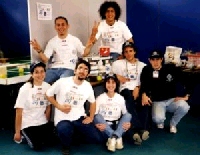
The Team:
Mattia FrascaCarmelo Ragusa Donata Nicolosi Manuela ? Filippo Colaianni Damiano Stella Matteo Caruso |
|
2000
|
 Ten balloons were disposed on the playing table of the year 2000, which was divided into two sides by a hill and a valley. The balloons were five blue and five yellow and four of them in random places. Each team had to burst the opponent's balloons in the opposite side of the playing ground. The use of projectiles was forbidden and the maximum size of a robot did not allow it to burst the balloons from afar.
A new chassis was realized for the main robot to carry four small robots and accomplish the size constraint. Two small robots were again tricycle systems piloted by the STMicroelectronics microcontroller ST5. They were released by the main robot via a plugged wire, and then they executed the pre-registered trajectory to burst some opposite balloons.
The other two robots, very small and with a single wheel, were released via an electromagnetic system on the track border to reach other two balloons. The main robot then tried to overcame the hill to reach the other side.
This year the team did not win the competition but received an award for their enthusiasm.
Ten balloons were disposed on the playing table of the year 2000, which was divided into two sides by a hill and a valley. The balloons were five blue and five yellow and four of them in random places. Each team had to burst the opponent's balloons in the opposite side of the playing ground. The use of projectiles was forbidden and the maximum size of a robot did not allow it to burst the balloons from afar.
A new chassis was realized for the main robot to carry four small robots and accomplish the size constraint. Two small robots were again tricycle systems piloted by the STMicroelectronics microcontroller ST5. They were released by the main robot via a plugged wire, and then they executed the pre-registered trajectory to burst some opposite balloons.
The other two robots, very small and with a single wheel, were released via an electromagnetic system on the track border to reach other two balloons. The main robot then tried to overcame the hill to reach the other side.
This year the team did not win the competition but received an award for their enthusiasm.
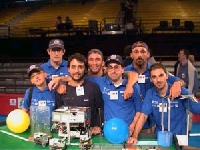
The Team:
Antonio Virzi’ Dario Briguglio Claudio Condorelli Alessandro Guzzetta Domenico Longo Claudia Bonomo |
|
2001
|
 The competition of 2001 was inspired by the space Odyssey: the two teams of robots had to conquer a galaxy using flags. The selection of the winner was based on the highness of the flags and on the number of planet and stars conquered. Two planets were not fixed to the ground and could be moved by the robots. This year the new student group realized the biggest robotic team: with 8 moving flags robots, four small transportation robots and a main robot.
At the start signal, the main robot released the two transportation robots via IR communication, these robots tried to conquer the moving planet releasing the transported robotic flag on their surface. Then the main robot tried to conquer the central star releasing a flag on its surface using a lifter. Then it rotates and conquers the other two fixed planet closed to it and finally goes to conquer the opposite planets. The robotic flags were piloted by a small Microchip microcontroller and using four IR sensors it could navigate on the top surface of the planet, trying to push down possible opposite flags. The main robot had an embedded PC Pentium 166 MHz running MiniRTL Linux (a real time mini-distribution of Linux); a terminal was realized using a 4*4 key-matrix and a 16*2 character display. The system was interfaced with the motion control board and the sensors using an expansion board based on the 8255 chips.
The competition of 2001 was inspired by the space Odyssey: the two teams of robots had to conquer a galaxy using flags. The selection of the winner was based on the highness of the flags and on the number of planet and stars conquered. Two planets were not fixed to the ground and could be moved by the robots. This year the new student group realized the biggest robotic team: with 8 moving flags robots, four small transportation robots and a main robot.
At the start signal, the main robot released the two transportation robots via IR communication, these robots tried to conquer the moving planet releasing the transported robotic flag on their surface. Then the main robot tried to conquer the central star releasing a flag on its surface using a lifter. Then it rotates and conquers the other two fixed planet closed to it and finally goes to conquer the opposite planets. The robotic flags were piloted by a small Microchip microcontroller and using four IR sensors it could navigate on the top surface of the planet, trying to push down possible opposite flags. The main robot had an embedded PC Pentium 166 MHz running MiniRTL Linux (a real time mini-distribution of Linux); a terminal was realized using a 4*4 key-matrix and a 16*2 character display. The system was interfaced with the motion control board and the sensors using an expansion board based on the 8255 chips.
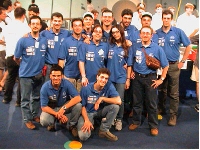
The Team:
|
|
2002
|
 The 2002 Eurobot competition consisted in a flying billiard where the holes were substituted by baskets. The playing field was flat and 12 balls were placed randomly on it complying with a central symmetry, eight of the balls were red and should be placed in the own baskets while the other four were black and should be placed in the opposite baskets.
This year the new team used a web cam to estimate the starting position of the balls, then the robot went towards them, while an automatic ball loading system was realized using some belts. An IR sensor was adopted to distinguish the colour of the loaded balls; while a set of ten IR sensors were used to localize the robot using the white lines plotted on the ground surface.
The robot was called Liotrobot since "Liotro" (that in Sicilian dialect means elephant) is the symbol of Catania city.
The 2002 Eurobot competition consisted in a flying billiard where the holes were substituted by baskets. The playing field was flat and 12 balls were placed randomly on it complying with a central symmetry, eight of the balls were red and should be placed in the own baskets while the other four were black and should be placed in the opposite baskets.
This year the new team used a web cam to estimate the starting position of the balls, then the robot went towards them, while an automatic ball loading system was realized using some belts. An IR sensor was adopted to distinguish the colour of the loaded balls; while a set of ten IR sensors were used to localize the robot using the white lines plotted on the ground surface.
The robot was called Liotrobot since "Liotro" (that in Sicilian dialect means elephant) is the symbol of Catania city.
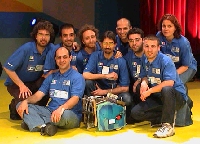
The Team:
|
|
2003
|
 Twelve two-coloured pucks are randomly placed on the 2003 playing ground respecting a central symmetry. The outer sides of the pucks are red and green but initially they are placed on their edge. The goal of the robotic teams was that of twisting the more pucks as possible in the side with the same colour assigned to the team just before starting the competition.
The name chosen by the new team was "Cesare", a single robot strategy was adopted also this year, the system was piloted only by microcontrollers, this to reduce the complexity, the power consumption and the booting time. Two stepper motors permitted to reach a good quality in the odometry, avoiding the needs of dedicated hardware for the quadrature decode of the encoder signals. Another motor was adopted to twist the disks if the colour acquired by an IR sensor was of the opposite team.
The robot was programmed to follow a predefined path and to localize itself by using odometry and IR sensors (to recognize the current colour of the ground).
Twelve two-coloured pucks are randomly placed on the 2003 playing ground respecting a central symmetry. The outer sides of the pucks are red and green but initially they are placed on their edge. The goal of the robotic teams was that of twisting the more pucks as possible in the side with the same colour assigned to the team just before starting the competition.
The name chosen by the new team was "Cesare", a single robot strategy was adopted also this year, the system was piloted only by microcontrollers, this to reduce the complexity, the power consumption and the booting time. Two stepper motors permitted to reach a good quality in the odometry, avoiding the needs of dedicated hardware for the quadrature decode of the encoder signals. Another motor was adopted to twist the disks if the colour acquired by an IR sensor was of the opposite team.
The robot was programmed to follow a predefined path and to localize itself by using odometry and IR sensors (to recognize the current colour of the ground).
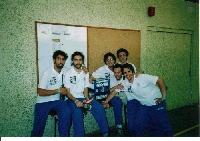
The Team:
Giuseppe BognannoAndrea Di Mauro Paolo Leone Matteo Marano Donato Melita Giuseppe Pavone |
|
2004
|
 The 2004 Eurobot competition was a Coconut Rugby match: eight coconuts (rugby balls) and two obstacles (coconut trees) were randomly laid out on the playing zone by referees at the beginning of each match. Each obstacle carried three coconuts on its top. Goals (poles and net) were located on each side of the playing zone. In order to win, each robot must score the most drops or tries in the opponent’s in-goal zone. The robots started from their in-goal zone and could remove balls from this zone during the competition reducing hence the opponent scores.
The new team realized two robots both of them were dual drive systems: the big one was called "Etna" while the second one "Trinità" (Trinity).
Also this year the main robot did not use a PC but a Microchip microcontroller was adopted to manage the robot trajectory and the stepper motors for locomotion. The net could be localized using three active beacons; two dedicated Nutchip processors were used to decode the beacons signals and to estimate the orientation of the robot in respect to the opposite net. A CMUcam was adopted to recognize the coconuts, while a simple relay was used to activate the DC motors of the balls loading system.
The small robot used a very simple but reliable strategy: moving randomly in the in-goal zone it was programmed to search for coconuts and to push them outside the in-goal zone using two rolls. A Microchip microcontroller was chosen to pilot the two modified servo motors for the locomotion, to acquire the IR sensors and the switches adopted to recognize the presence of obstacles or the outer border and to activate the rolls motor. A CMUcam was used to identify the coconuts.
The 2004 Eurobot competition was a Coconut Rugby match: eight coconuts (rugby balls) and two obstacles (coconut trees) were randomly laid out on the playing zone by referees at the beginning of each match. Each obstacle carried three coconuts on its top. Goals (poles and net) were located on each side of the playing zone. In order to win, each robot must score the most drops or tries in the opponent’s in-goal zone. The robots started from their in-goal zone and could remove balls from this zone during the competition reducing hence the opponent scores.
The new team realized two robots both of them were dual drive systems: the big one was called "Etna" while the second one "Trinità" (Trinity).
Also this year the main robot did not use a PC but a Microchip microcontroller was adopted to manage the robot trajectory and the stepper motors for locomotion. The net could be localized using three active beacons; two dedicated Nutchip processors were used to decode the beacons signals and to estimate the orientation of the robot in respect to the opposite net. A CMUcam was adopted to recognize the coconuts, while a simple relay was used to activate the DC motors of the balls loading system.
The small robot used a very simple but reliable strategy: moving randomly in the in-goal zone it was programmed to search for coconuts and to push them outside the in-goal zone using two rolls. A Microchip microcontroller was chosen to pilot the two modified servo motors for the locomotion, to acquire the IR sensors and the switches adopted to recognize the presence of obstacles or the outer border and to activate the rolls motor. A CMUcam was used to identify the coconuts.
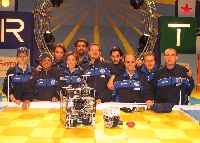
The Team:
|
|
2005
|
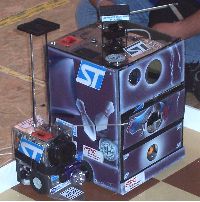 The 2005 The 2005 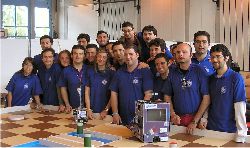
The Team:
|
|
Images and Videos
|
|
|
|
Links
|
|
Publications
|
|